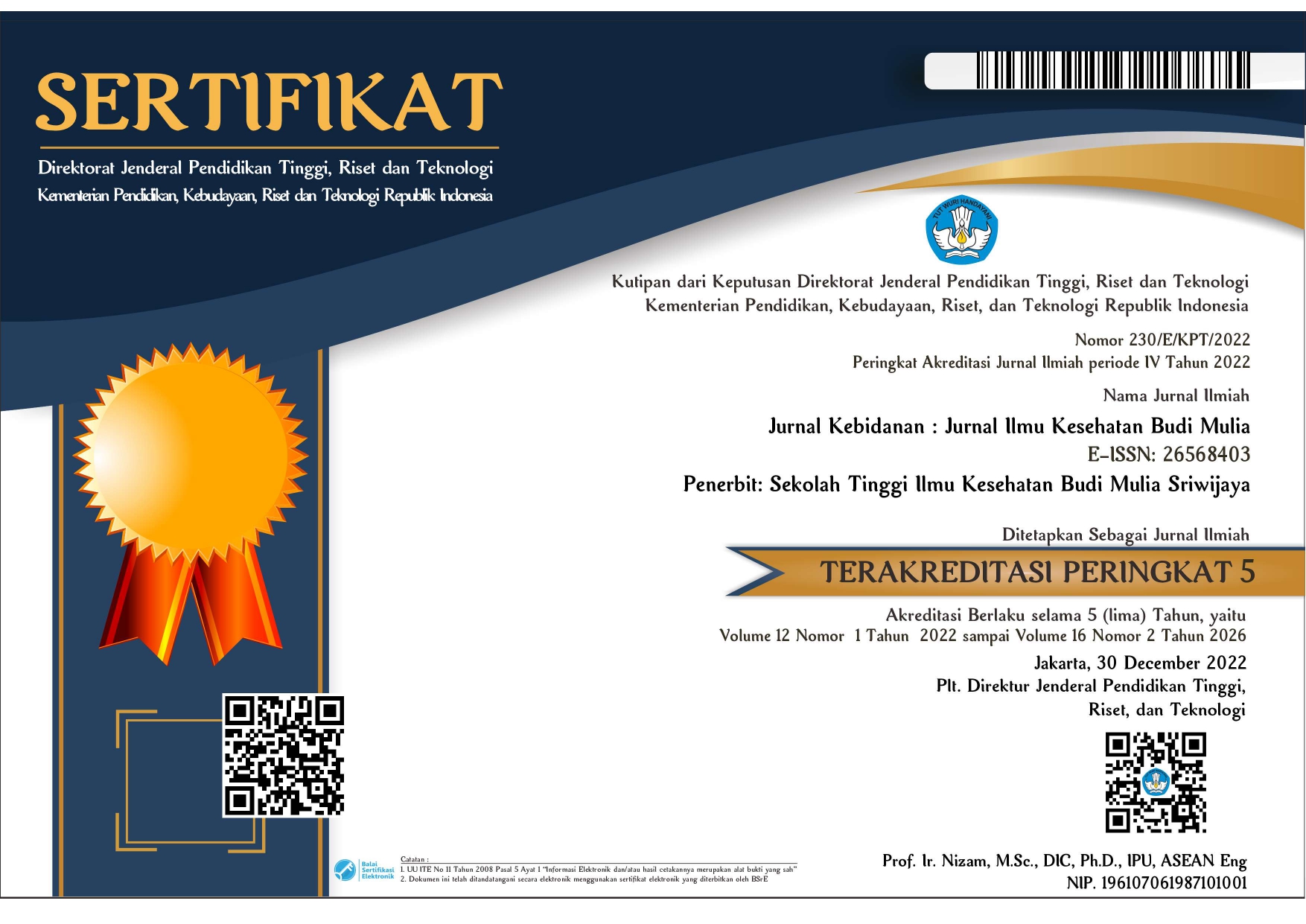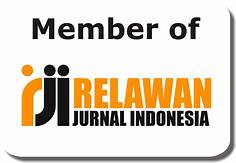HUBUNGAN PENINGKATAN BERAT BADAN DAN KETIDAKTERATURAN SIKLUS HAID DENGAN PENGGUNA KB SUNTIK PADA AKSEPTOR KB DI PUSKESMAS PEMBINA PALEMBANG TAHUN 2018
Abstract
ABSTRAK
Kontrasepsi Hormonal sebagai salah satu alat Kontrasepsi meningkat dan tajam. Menurut World Health Organization (WHO) 2014, Pengguna alat kontrasepsi suntik yaitu 35,3%, pil yaitu 30,5%, IUD yaitu 15,2%, Implant 7,3%, dan 11,7% Kontrasepsi lainnya. Tujuan penelitian ini untuk mengetahui apakah ada hubungan peningkatan berat badan dan ketidakteraturan siklus haid dengan KB suntik pada akseptor KB di Puskesmas Pembina Palembang Tahun 2018.Rumusan masalah penelitian ini adalah hubungan antara umur dan pengetahuan akseptor tentang KB Suntik di Puskesmas Pembina Palembang Tahun 2018.Penelitian ini menggunakan survey analitik dengan pendekatan cross sectional yang dilakukan dengan kuesioner.Uji Statistic yang dipakai adalah Uji Chi-Square. Populasi dalam penelitian ini berjumlah 62 orang dan seluruh Populasi dijadikan sampel. Dari hasil analisa univariat responden yang memakai KB Suntik lebih besar yaitu sebanyak 36 orang (58,1%), dan 26 orang (41,9%) yang tidak memakai KB Suntik. Responden yang berat badannya meningkat memakai kontrasepsi sebanyak 33 orang (53,2%), sedangkan responden yang berat badannya tidak meningkat sebanyak 29 orang (46,8%) dibandingkan dengan responden yang siklus haidnya tidak teratur adalah sebanyak 32 orang (51,6%). Hasil analisa statistik dengan menggunakan Uji Chi-Square dengan df = 1 ada hubungan yang bermakna peningkatan berat badan dengan KB Suntik pada akseptor KB diperoleh p value (0.006) lebih kecil dari (0,05) dan ada hubungan yang bermakna ketidakteraturan siklus haid dengan KB suntik pada akseptor KB diperoleh p value (0,011) lebih kecil dari (0,05). Saran agar petugas kesehatan meningkatkan kinerja dan sistem informasi mengenai masalah yang berhubungan dengan pemakaian KB Suntik.
ABSTRACT
The hormonal contraception as becoming on of the contraceptions tools which is increasing sharply. Based on world Health Organitation (WHO) the user of injected contraception is 35,3%, pill 30,5%, IUD 15%, implant 7,3%, and 11,7% for another contraception. The purpose of this research is for knowing wheter there is the increasing of weight and the irregular of monthly period with injected contraception for the acceptor at Puskesmas Pembina Palembang in 2014. The main case of this research is the relationship between the increasing of the weight and the irregular monthly period at Puskesmas Pembina Palembang in 2014. This research using analytic survey with cross sectional closing yhat was done by using questioner, the statistic test which take is Chi-Square test. The population in this reseacrh are 62 peoples, and all off them as becoming the sample from the result of respondent univariat analyze whom using the injected contraception in bigger that is exactly 36 people (58,1%) and 26 people (41,9%) whom do not using it. The respondent with their weight is increasing because of using contraception is 33 people (53,2%), while the respondent whom the weight do not increasing is 29 people (46,8%), when we compare with the respondent whom the monthly period is irregular are 32 people (51,6%). The result for statistic analyze by using the Chi-Square test with the df = 1 says that there is a significant relationship between the weight increasing with the injected contraception for the acceptor we get p value (0,006) is smaller than (0,05) and there is significant relationship between the injected contraception for the acceptor we get p value (0,011) with is smaller than (0,05). The sugestion of the health workes to increasing the performance the information sistem about the problem that is connected with the inject contraception using











